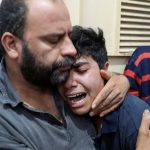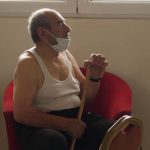From night ambushes on quad bikes and attacks with drones to the deliberate sabotage of road and railway bridges, Ukrainian forces have repeatedly thwarted Russia’s war plans.
It means, on Moscow’s annual Victory Day on Monday, any attempt by Russian President Vladimir Putin to claim that his invasion of Ukraine is succeeding has been significantly undermined, according to Ukrainian defenders involved in the fight.
They said their unconventional tactics helped prevent Russian troops from conducting what was meant to be a lightning strike on the capital in the initial phase of the offensive.
Ukraine’s ability to resist also points to Russia facing a costly war of attrition in the south and east of the country, though the threat of a second push towards Kyiv remains. It is something Ukrainian forces in the capital said they are ready for and will again repel.
The first Battle for Kyiv, which began when President Putin launched his invasion of Ukraine on 24 February, was a ferocious, five-week fight that pitched Ukrainian troops, border guards and volunteers against one of the world’s most powerful militaries.
Western defence experts had predicted the capital would fall within days.
But the Ukrainian side, helped by a clear plan of defence and assisted by a flow of increasingly lethal Western weapons, defied the forecast and pushed Russian troops into reverse, forcing them to regroup and reposition themselves in the east.
Sky News spoke to Ukrainian soldiers, border guards and volunteers involved in the battle as well as ordinary families whose lives have been devastated by Russia’s war.
These are their stories.
‘Two killed and 60 under debris’ after Russia ‘drops bomb on school’ – Ukraine war latest
The invasion
One of Russia’s first targets at just after 4.30am on day one of the invasion was a border guard post in forestland close to Ukraine’s border in the north with Belarus.
Major Artem Lazutin, 41, said a drone dropped explosives on a group of tents where border guards had been camped out sleeping, injuring seven of them.
“Hearing those explosions, I realised the war had begun,” he said.
The officer and other border guards took up defensive positions next to a major motorway bridge and also a railway bridge, both leading to Belarus across the Dnipro River.
“That afternoon, working with the military, we blew up the bridges with mines to prevent any Russian vehicles from being able to cross,” he said.
The deliberate destruction of bridges was a tactic used repeatedly by the Ukrainian defenders to frustrate the Russian advance.
Yet the overwhelming volume of tanks, armoured vehicles, artillery, trucks and other elements of Russia’s military machine was too great for the Ukrainian defenders.
The border guards were largely pulled back to help defend key northern cities such as Chernihiv, though a number of personnel ended up behind enemy lines.
From there, they risked their lives providing information on the movement and location of Russian positions, according to the head of the national border guard force in the wider Chernihiv region.
Asked how he felt when he realised Russian troops were invading, Colonel Oleksandr Chornyi said: “I wanted to destroy them all and expel them from our land. This desire has not disappeared. I think every Ukrainian will fight until all these evil spirits leave our territory.”
Russian commanders targeted Kyiv and the north of the country by land from multiple entry points – moving in from Belarus, down through the regions of Chernobyl and Chernihiv in the north, and entering from Russia, through Ukraine’s north-eastern Sumy region.
They also launched an air assault to try to capture what should have been a main day one objective – an airport in an area called Hostomel, about 12 miles northwest of Kyiv.
Some of the most elite Russian paratroopers landed in helicopters in sprawling countryside outside the airbase, others tried to land at the facility directly.
They needed to capture the civilian airport, home to the world’s largest transport aircraft, because Russia wanted to be able to land their own transport planes on the runway to fly in hundreds of troops who would then take part in the assault on Kyiv.
But Ukrainian forces had other plans.
Read more: UK pledges extra £1.3bn in military support for Zelenskyy’s forces
One commander, who asked not to give his name, was in charge of helping to defend the airport on the first day. He saw the Russian helicopters swooping in low at about 11am.
Russian missiles blasted a minibus at the front airport as the assault started.
Ukrainian defenders opened fire, smashing at least three helicopters out of the sky. They also had to confront the paratroopers who had landed.
“We fired on them for as long as we had ammunition,” the commander said, his face covered with a black balaclava. “We then directed our own artillery onto the runway to damage it. This prevented the enemy from being able to land their transport aircraft.”
Once out of ammunition, the commander moved his forces back.
The airport and surrounding area on the outskirts of the capital became a critical frontline over the next five weeks as the Battle for Kyiv raged.
The human cost
Russian forces were ultimately beaten back, though not before inflicting huge damage.
The town of Bucha, close to Hostomel, was among the most scarred.
The discovery of a mass grave in the grounds of a church, bodies in the street and evidence of torture, murder and rape, triggered global horror. International investigators are working with the Ukrainian authorities to charge Russia with war crimes.
But the trail of terror is vast and can be traced right back to the border with Belarus.
One of the less well-known sites of misery is Yahidne, a small, once-picturesque farming village, just outside the northern city of Chernihiv.
It now lies in ruins.
Russian troops effectively held more than 300 villagers – including over 60 children – captive in the basement of a school for almost a month as they occupied the village.
There was no ventilation in the crammed, underground space, limited access to food and water and bombs dropping outside.
The only light came from candles. The only distraction for children, aged from just two months old to teenagers, was a slim collection of school books and some crayons.
Families were packed together, with infants sleeping on blankets on the floor while terrified parents sat on tiny school chairs, watching over them.
For a number of the elderly, the conditions were a death sentence.
As many as 12 people died in the basement, survivors said. At times it was not possible to move the bodies of the dead for several days, meaning they lay amongst the living.
Tania, a local resident, did not want to give her full name.
She stayed in the basement with her husband and their two boys, aged 10 and 12.
A bucket was used as a communal toilet. When bombs exploded outside, she would lay herself over her children – as other parents did – to try to protect them.
“I was horrified when someone died – and when you find yourself in such circumstances, with a dead person lying next to you,” Tania said. “It was scary. When the second and third person died, there was a feeling that maybe we would all die soon.”
The names of some of those who perished in the basement have been scribbled in black on the wall as well as the names of villagers who were killed in the Russian bombardments.
Children drew on the walls as well to help pass the time. There are pictures of people with sad faces and also calendars, counting the days spent underground.
Tania described her relief when Ukrainian forces finally managed to push the Russian troops out of the village as part of a sudden withdrawal across the whole of the north.
“On 1 April we saw that our flag was peeking out of the woods. It was such a moment,” she said, starting to cry with relief at the memory.
“They [Ukrainian troops] came here. We shouted that we are civilians, we shouted: ‘Glory to Ukraine’. They responded: ‘Glory to the heroes’. They came here. We hugged. It was a long-awaited moment.”
At 86, Oleksiy Potiy, another Yahidne resident, emerged from the basement as the oldest person in the village after those more elderly than him perished.
He lived through the Second World War, but nothing could prepare him for Russia’s invasion.
“They all died, suffocated, because there was simply not enough air,” he said about those who did not make it out alive, admitting that he had thought he would be next.
“When I returned home, I went to the bathroom to wash. I was scared to look at myself in the mirror – there were only bones,” Mr Potiy said, prodding at a jacket sleeve to show how thin his left arm had become.
Like many people across the north and in Kyiv, he is fearful that Russian forces could return.
“I am still anxious,” Mr Potiy said, leaning on a walking stick.
“Whenever I hear a bang, I think: What is it?”
Drones, quad bikes and the fightback
The impact of the invasion could have been even worse.
In the beginning, a 40-mile column of Russian armoured vehicles had been bearing down on Kyiv, amid warnings the capital could imminently fall.
But the column appeared to stall for days and then dispersed as it came under insurgent-style attacks.
Ukrainian defenders said remote-controlled mines were used to target a number of the vehicles.
At the same time, small groups of fighters, some using quad bikes, night vision goggles, drones and sniper rifles, would venture up to Russian positions, strike them and then speed away, according to a commander with knowledge of the missions.
“You should not imagine we are like guys from the movie Mad Max but yes we used quad bikes… because they are very mobile,” said Lieutenant Colonel Yaroslav Honchar.
“You can move close to some positions and quickly go back.”
A target for the assaults was Russia’s logistic and supply lines such as food and fuel stores. Without access to vital supplies, even the mightiest army will fail.
Lieutenant Colonel Honchar is the co-founder of Aerorozvidka, a civilian, non-governmental organisation (NGO) that supports the military with its aerial reconnaissance expertise.
It was set up after Russia’s first invasion of Ukraine in 2014 and uses the technical skills of civilians with a background in areas like engineering and IT to bolster Ukraine’s defences by developing clever drone and surveillance technology that is used by troops.
Aerorozvidka is an example of how civilian volunteers play a vital role in Ukraine’s war effort alongside professional, full-time military personnel.
Drones fitted with cameras and armed with explosives have been an important weapon to counter Russia’s superior firepower.
Cheap and easy to build, they are taking out far more complex and costly weapons systems like tanks and radars.
A huge number of videos, including those released by Aerorozvidka on YouTube, show Ukrainian drones destroying Russian targets.
Vadym, who asked just to give his first name, is part of the reconnaissance unit.
He is known as the father of the drone after developing a model, with eight helicopter-style blades, that is used by Ukrainian troops.
He said the aircraft played an important role in winning the Battle for Kyiv.
“Firstly, drones identify the location of the enemy armoured vehicles,” Vadym said, speaking while operating one on a test flight.
“Secondly, these are shock drones. They can hit quickly.”
More conventional Ukrainian forces were also critical to the defence of the capital.
Lieutenant Colonel Oleg Kobzarenko commanded an artillery battalion that helped to block the invading forces from making another important river crossing, this time over the Irpin River in the village of Gorenka on the outskirts of Kyiv.
“If Russian troops had been able to enter Gorenka, it would mean a 90% chance that nothing would stop them from making it to Kyiv,” he said.
“It meant Gorenka could not be surrendered under any circumstances. Here people stood entrenched until the end. They understood that Kyiv was behind them and there was nowhere to retreat to.”
Ukrainian forces again destroyed river crossings, before aiming fire on Russian positions.
The commander said that his troops had British and other Western weapons, including anti-tank missiles, which proved vital.
“It would have been several times harder” to repel Russian forces without them, he said.
Asked whether he had a message for President Putin ahead of Russia’s annual Victory Day on Monday, Colonel Kobzarenko said: “I have no desire to address to the occupier, to the enemy… We understand that they had been planning – dreaming – of wanting to hold a parade in Kyiv on 9 May. Unequivocally, they wanted to make a theatre of the absurd and show the world that they had won.
“Now I understand that they want to reduce their enthusiasm, ambitions a little bit and at least show their victory somewhere – in Mariupol or in the east of Ukraine. But Ukraine will never be defeated. We will endure and will stand to the end. This is our land. We do not claim their territory, but we will never give up ours.”






















